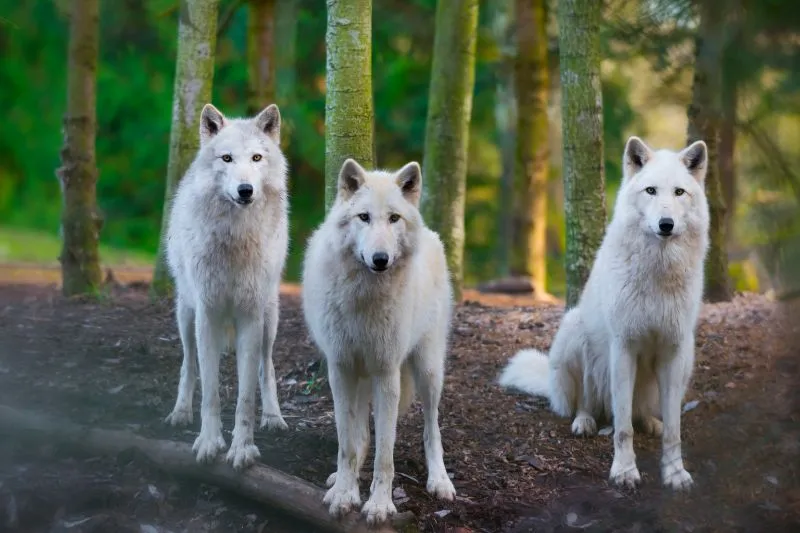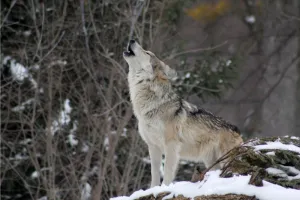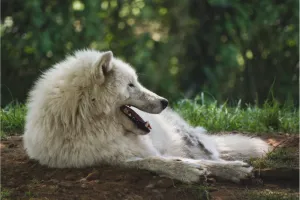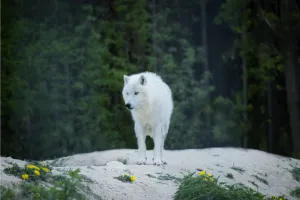Wolves are an ancient ancestry dating back to a time before modern humans emerged. Arctic wolves have branched off from this ancestry, forming distinct populations adapted to the cold, arctic conditions. Their determination to survive in a sub-zero climate has made them one of the most fascinating predator species on the planet! Therefore, their protection and conservation should be revered as an important point of discussion. So, how many arctic wolves are left, and are they endangered?
Arctic wolves are not currently endangered. They are classified as ‘Least Concern‘ by the IUCN Red List. They live in isolated high arctic regions and rarely come into contact with humans. Therefore, for the most part, arctic wolves avoid harmful human activities such as hunting. However, in recent years, arctic wolves’ homes have become increasingly impacted by climate change and urbanization.
Read on to find out more about the effects of climate change and why the arctic wolf is so important for the high arctic ecosystem.

How Many Arctic Wolves Are Left in the World?
Arctic wolves live on various arctic islands in extreme isolation from human inhabitants. Sightings are rare and often an inaccurate representation of pack size due to pups remaining hidden in wolf dens. Due to this, it is very difficult for researchers to reach a conclusion on just how many arctic wolves are left in the world. This was one of the reasons the arctic wolf was denied ‘protected’ status from the Committee on the Status of Endangered Wildlife in Canada (COSEWIC) in 19991 (source: Northwest passages: conservation genetics of Arctic Island wolves | SpringerLink (gla.ac.uk).
The arctic wolf can be found in the high Arctic regions of Canada and the northern and eastern shores of Greenland.2 (source: Population genomics of grey wolves and wolf-like canids in North America | PLOS Genetics). Within the Canadian Arctic Archipelago, they can be found on Victoria Island, Banks Island, Baffin Island, and Ellesmere Island.3(Source: Population genomics of grey wolves and wolf-like canids in North America | PLOS Genetics)
Researchers have noted 303 arctic wolf sightings in Greenland between 1978-19984 (source: Insular and disjunct distribution of the Arctic wolf in Greenland, 1978–1998 | SpringerLink (gla.ac.uk). Another study sighted an estimated 950 individuals over 12 years in Northwestern Canada5 (source: Wolf–Caribou Dynamics Within the Central Canadian Arctic (gla.ac.uk).
Via accumulation of population surveys, models, and research; a suggestion of ~2000 arctic wolves left in the wild has been made.
Importantly, the IUCN Red List classifies the species as ‘ Least Concern’ (LC).
Are Arctic Wolves Endangered?
The IUCN red list has classified arctic wolves as ‘Least Concern’ (LC). A ‘Least Concern’ classification is applied to species whose populations are still abundant in the wild. The species does not, at present, require specific and focused conservation efforts.
Due to the arctic wolves’ extreme isolation within Greenland and the Canadian Arctic Archipelago, they come in contact with very few humans. This allows the arctic wolves to remain relatively untouched by the harmful effects of human interference.6 (source: https://journals.plos.org/plosgenetics/article?id=10.1371/journal.pgen.1007745). They are not nearly as negatively affected by hunting and habitat destruction as their close relative – the North American grey wolf.
However, it should be noted that in less isolated Canadian islands, hunting and commercial use of the arctic wolves can occur. This can annually decrease populations by 25%. 7(Source: Northwest passages: conservation genetics of Arctic Island wolves | SpringerLink (gla.ac.uk)
Will Arctic Wolves Go Extinct?
Although arctic wolves are not currently endangered, this can change over the next few decades due to the rapidly deteriorating state of biodiversity across the Earth.
Arctic wolves live in the arctic tundra; a vast snowy landscape, lacking trees and regular rainfall. Few animals on earth can withstand this habitat. Yet, year after year arctic wolves survive in this hostile environment through novel adaptations such as increased blood flow to their paws.
However, this way of life is threatened by human processes such as urbanization and industrial development…
Industrial development has been increasingly infringing on arctic wolf habitats over the last number of years. The building of roads and mines in high arctic areas can:
- Damage vegetation
- Release toxins: Toxins released by urbanization and industrial activity also threaten the arctic wolves’ way of life. Industrial activity can cause a build-up of toxic mercury in the Arctic. This is extremely harmful to the arctic wolf and all wildlife inhabiting the tundra.8 (source: Tundra Threats Explained | National Geographic Society)
- Decrease the size of artic wolf territories.9 (source: Arctic Wolf | Species | WWF (worldwildlife.org) Large and well-protected territories are key to the survival of the arctic wolves. If territories are reduced, the wolves will struggle to find sufficient amounts of food to survive the harsh winter. Starvation and pup desertion can quickly occur. Reduced territories can also increase conflict with rival wolf packs leading to lethal den raids and loss of life.10 (source: How do wolves choose the size of their territory? (wolf.org)
These processes can lead to the severe endangerment of the arctic wolf. Once this occurs it is very difficult to undo the damage done. Therefore, wildlife groups are urging members of the public to support the repeal of Arctic refuge oil and gas programs to prevent the extinction of the arctic wolf from becoming a reality in our lifetime.11 (source: Arctic Wolf | Species | WWF (worldwildlife.org)

How Does Climate Change Affect Arctic Wolves?
Climate change is a phenomenon spurred by human activities that result in long-term changes in temperature and weather patterns. It affects the arctic wolves by disrupting their food supply.
Arctic wolves are carnivores. They prey on arctic hares, caribou, and muskoxen – herbivores found in the arctic tundra that are vulnerable to temperature shifts and strange weather patterns.12 (source: Annual Arctic Wolf Pack Size Related to Arctic Hare Numbers on JSTOR)
In the Arctic, the summer months are a period of recovery and preparation for the winter ahead. It is a necessary period of replenishment for the prey populations. This is threatened by climate change which causes summer temperatures to fall and rainfall to increase. This results in the appearance of snow as early as the middle of August.
Early snowfall creates hard, impenetrable layers of ice over vegetation such as lichen (a vital food source of the caribou). This stops prey populations from successfully foraging and reaching their food.
With food harder to reach, and their recovery period cut short, the prey populations find it increasingly difficult to survive and reproduce.
Many researchers have found that when the prey populations suffer, so do the arctic wolves. Consequentially, widespread starvation and loss of life occur.13(source: Is climate change affecting wolf populations in the high arctic? (springer.com) Climate change – WWF Arctic (arcticwwf.org)
This phenomenon was seen on Ellesmere Island in the years 1997 and 2000. Populations of arctic hares and muskoxen declined to a point that resulted in a subsequent population decline of the arctic wolves.14 (source: Annual Arctic Wolf Pack Size Related to Arctic Hare Numbers (jstor.org).
Why Are Arctic Wolves Important?
Arctic wolves are very important in numerous ways…
- Maintain plant diversity: Arctic wolves play an important role as the only terrestrial carnivore in the arctic tundra15 (source: Northwest passages: conservation genetics of Arctic Island wolves | SpringerLink (gla.ac.uk). Their removal from the food web would have cascade effects across trophic levels – including herbivores, and vegetation. If allowed, herbivore populations would expand to unsustainable numbers, and over-consume vegetation leading to a reduction in plant diversity across the tundra. The arctic wolves’ presence and predation prevent this from happening.16 (source: (PDF) The importance of predators (researchgate.net)
- Maintain healthy prey populations: Arctic wolves prey on older, injured, or very young individuals within prey populations of arctic hares, caribou, and muskoxen. This allows only the fittest animals to survive and produce healthy offspring. The wolves also prevent the spread of disease within a prey population by feeding on sick individuals.
- Research: Arctic wolves are a hot topic for research. Their relatively recent migration and separation from the North American grey wolves is one of curiosity within the scientific community. Recently, research looking into the genetic diversity of wolves has found that three distinct populations of arctic wolves have been classified.17 (source: https://journals.plos.org/plosgenetics/article?id=10.1371/journal.pgen.1007745). The continued support and protection of the arctic wolves can lead to even more fascinating findings.
- Novel adaptations: Arctic wolves have adopted novel morphologies and behaviors that allow them to survive sub-zero temperatures. These include having shorter extremities, increased blood flow to their paws, and two layers of fur. Many of these mechanisms are unique only to the arctic wolf. For example, no other wolf on the planet has the white coloration seen in arctic wolves. Losing arctic wolves would mean losing these remarkable and unique strategies for survival.

What Would Happen If Arctic Wolves Increased In Population?
If the population of Arctic wolves were to increase, it could have various ecological and environmental impacts in their habitat. Here are some potential outcomes:
- Prey Population Dynamics: With an increase in the number of Arctic wolves, there could be a higher predation pressure on their primary prey species, such as muskoxen and Arctic hares. This could lead to a decline in prey populations, affecting the balance of the Arctic ecosystem18 (source: National Geographic. “Arctic Wolf.”).
- Trophic Cascade Effects: Changes in prey populations can trigger a trophic cascade, where the reduction in prey species influences other components of the food web. For example, a decrease in herbivore populations could lead to increased vegetation growth, impacting the availability of resources for other herbivores and altering plant community dynamics 19(source: WWF. “Arctic Wolf.”.
- Competitive Interactions: A larger population of Arctic wolves might result in increased competition for limited resources such as food and territory. This competition could intensify within and between wolf packs, potentially leading to changes in pack dynamics and social structures20 (source: The Arctic Institute. “Canis lupus arctos: The Arctic Wolf.”).
- Ecosystem Resilience: Despite potential short-term fluctuations, the long-term impact of an increased Arctic wolf population on the ecosystem’s resilience is uncertain. As a top predator, Arctic wolves play a vital role in maintaining the ecological balance by regulating prey populations and shaping the distribution and behavior of other species in their environment21 (source: The Wolf Conservation Center. “Arctic Wolf.”).

Related Questions
Where Do Arctic Wolves Live?
Arctic wolves live in the high Arctic regions of Canada and Greenland. In the Canadian Arctic Archipelago, they can be found on Victoria Island, Banks Island, Baffin Island, and Ellesmere Island. In Greenland, populations have been sighted along the northern and eastern shores. These regions are vast, treeless landscapes consisting of permafrost, snow, and very little human activity.
What Does The Arctic Wolf Eat?
Arctic wolves primarily eat meat including fish, invertebrates, and mammals such as lemmings, caribou, arctic hare, and muskox22 (source: Canadian Journal of Zoology, F.Dalerum, et al, Vol 96, No. 3, 2018). They hunt and kill most of their food, but will also scavenge on carcasses left by polar bears and other predators. Read more about the diet of arctic wolves.
How Do Arctic Wolves Adapt to the Extreme Arctic Climate?
Arctic wolves have remarkable adaptations that enable them to survive in the extreme Arctic climate. They possess a thick white fur coat that provides insulation and camouflage in the snowy landscape23 (source: Arctic Wolf Project. “Physical Adaptations of the Arctic Wolf.”). Their compact body structure minimizes heat loss, and their small ears help reduce frostbite risk. Furthermore, they have specialized blood circulation and metabolic systems that enable them to withstand extremely low temperatures and conserve heat24 (source: The Wolf Conservation Center. “Adaptations.“).
What is the Role of Pack Dynamics in Arctic Wolf Societies?
The role of pack dynamics in Arctic wolf societies is essential for their survival and social structure. Pack dynamics refer to the interactions, hierarchy, and cooperative behaviors within a group of wolves. Here are some key aspects of pack dynamics:
- Social Bonding: Pack dynamics foster strong social bonds among individual wolves, particularly within family units. These bonds are crucial for successful cooperative hunting, territory defense, and raising offspring25 (source: National Geographic. “Arctic Wolf.”)
- Leadership and Hierarchy: Packs are typically led by an alpha pair, consisting of the dominant male and female. They are responsible for making important decisions, such as hunting strategies and pack movements. Subordinate wolves within the pack respect the leadership hierarchy, ensuring order and coordination26 (source: National Geographic. “Arctic Wolf.”).
- Cooperative Hunting: Arctic wolves rely on cooperative hunting techniques to capture prey that may be larger or faster than an individual wolf can handle alone. Pack members collaborate in strategic group efforts, which increase hunting success rates and optimize resource utilization27 (source: National Geographic. “Arctic Wolf.”).
- Offspring Rearing: Pack dynamics play a vital role in the successful rearing of wolf pups. Other members of the pack contribute to the care and protection of the offspring, providing them with valuable socialization and learning opportunities28 (source: National Geographic. “Arctic Wolf.”).
The complex interplay of pack dynamics allows Arctic wolves to function as a cohesive unit, enhancing their chances of survival in the challenging Arctic environment.




